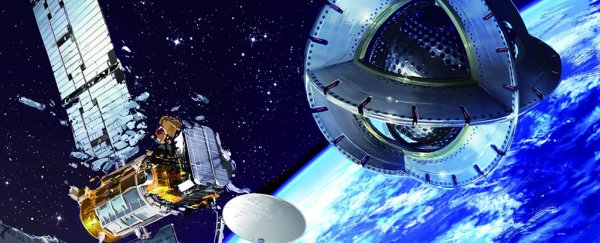One scientist is working on a novel solution for knocking dead, broken satellites out of orbit so they can't cause any damage to other spacecraft: a magnetic grappling beam.
The same technology could also be used to keep groups of new satellites in orbit, according to experts, which might one day enable us to combine packs of satellites flying in formation to create giant telescopes.
The magnetic tug idea is being researched by Emilien Fabacher, from the University of Toulouse in France, with help from the European Space Agency (ESA), and it would involve a chaser satellite being sent up into orbit to nudge redundant ones out of their paths.
"With a satellite you want to deorbit, it's much better if you can stay at a safe distance, without needing to come into direct contact and risking damage to both chaser and target satellites," says Fabacher.
"So the idea I'm investigating is to apply magnetic forces either to attract or repel the target satellite, to shift its orbit or deorbit it entirely."
Bear in mind that these satellites weigh several tonnes and are travelling at thousands of kilometres an hour to stay in a stable orbit above the Earth, so getting a hold of one is no easy task. At those kind of speeds, any wrong moves could be disastrous.
With an invisible magnetic tug designed to react with a satellite's magnetorquer—the bit of equipment that keeps satellites steady above the Earth's magnetic field—the redundant object's position in space could be shifted.
On board the chaser satellites, meanwhile, superconducting wires cooled to cryogenic temperatures would be used to generate a magnetic field strong enough to influence the satellites they were chasing.
It's still very much early days for this idea, and so far no research has been published by Fabacher. But the ESA says similar magnetic forces could keep satellites in formation above Earth, as close as 10-15 metres (33-49 feet) apart.
If scientists can get satellites to fly close enough, we could turn them into giant telescopes to peer deeper into space or even back at planet Earth, an idea the ESA has been working on for several years.
For now, Fabacher is running calculations on how all of this would work, and the part Earth's own magnetosphere might play in any future missions.
If it comes off, these chaser satellites could one day end up helping to solve our space junk problem. Of the estimated 21,000 objects larger than 10cm (4in) in size currently orbiting the Earth, only a small fraction are operational satellites.
Huge nets and robot arms have been discussed as ways of catching and dealing with the dead satellites out beyond Earth's atmosphere, but no one's hit upon a winning solution yet. As for Fabacher, he was first encouraged to pursue the idea after discussing it with experts from the ESA.
"The first surprise was that it was indeed possible, theoretically – initially we couldn't be sure, but it turns out that the physics works fine," Fabacher says.
Let's hope the rest of his plan works out fine too, and we can avoid any potentially nasty space collisions.
